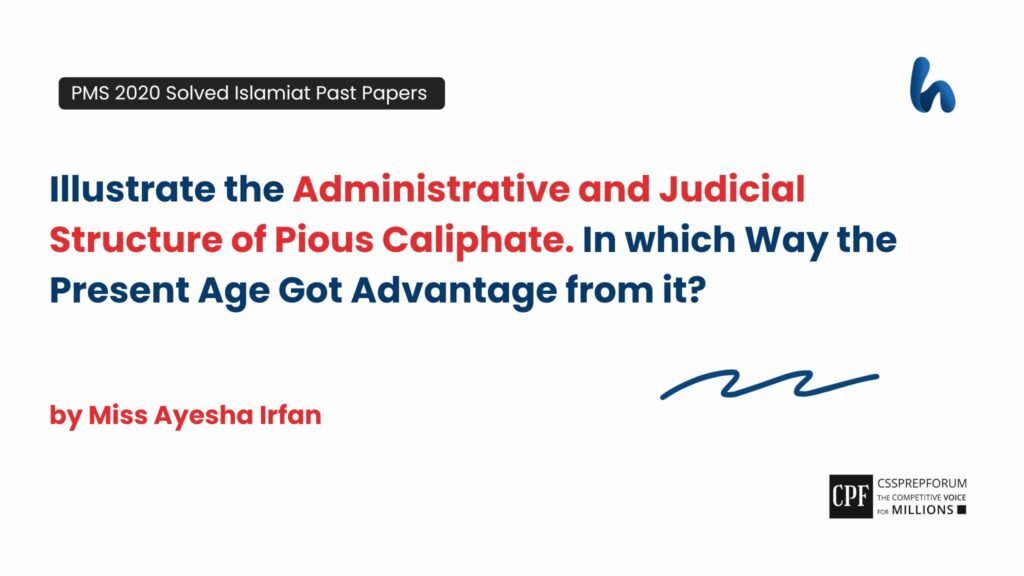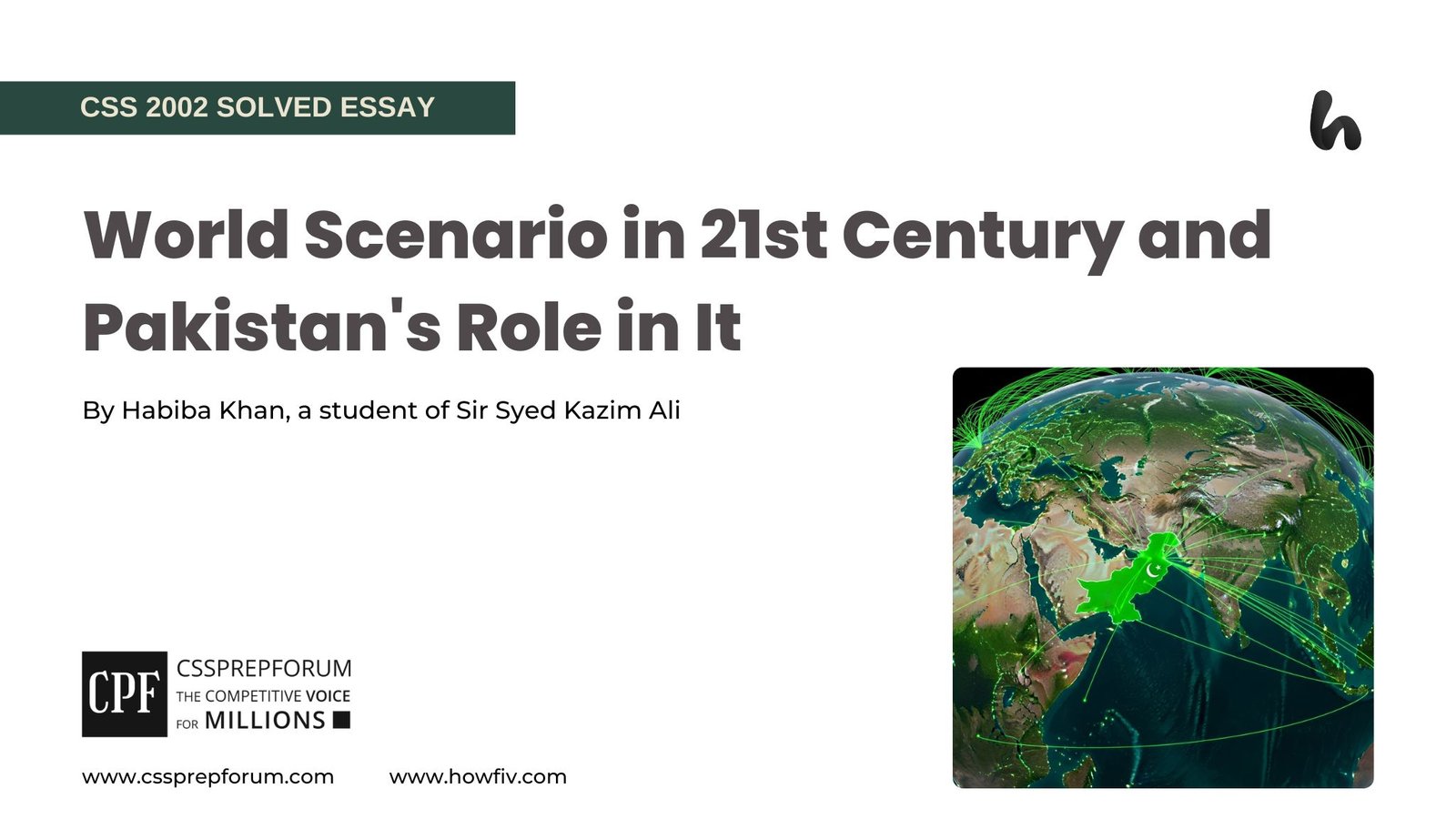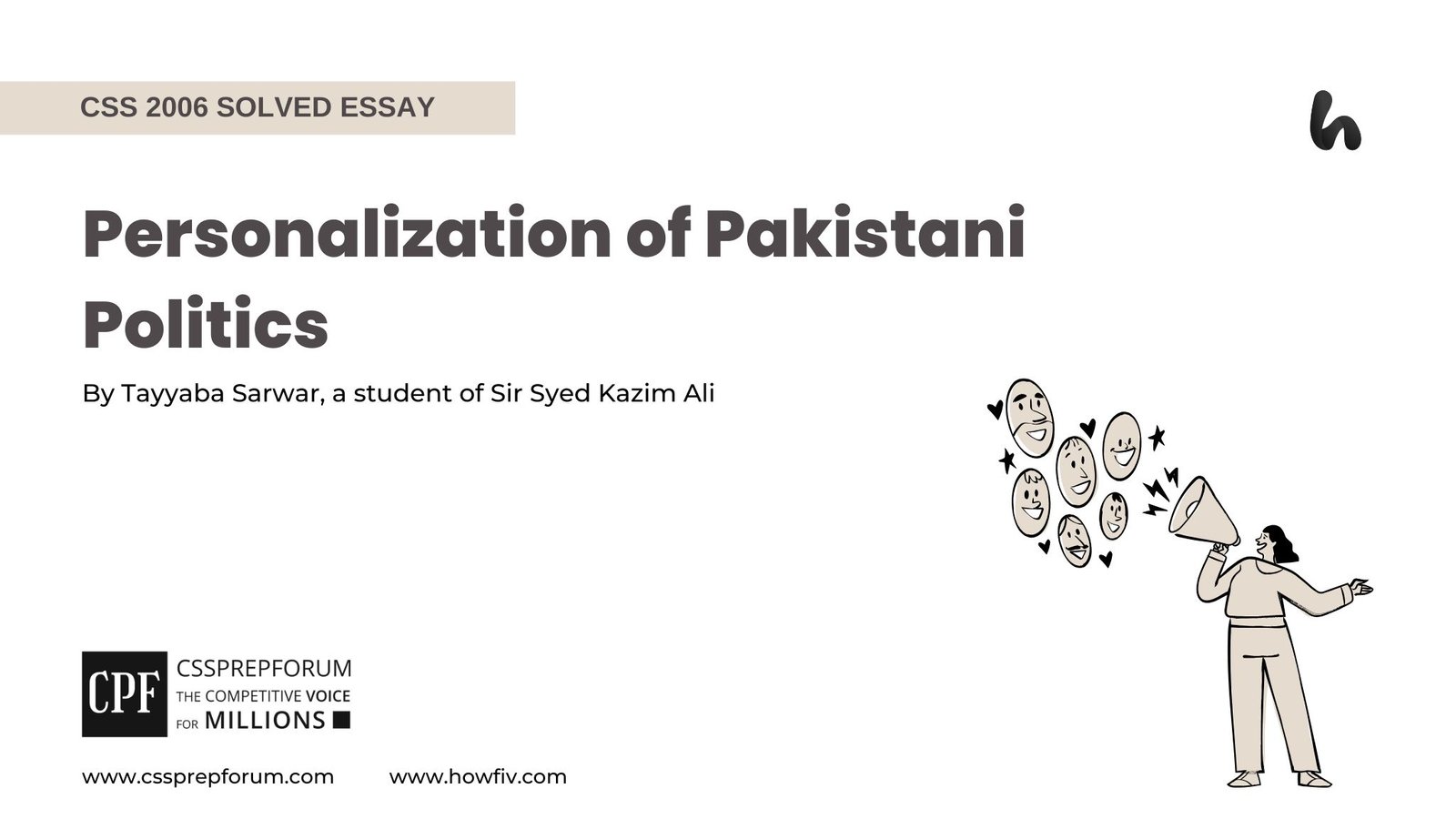PMS 2020 Solved Islamiat Past Papers | Administrative and Judicial Structure of Pious Caliphate
The following question of PMS Islamiat 2020 is solved by Miss Ayesha Irfan, the highest scorer in CSS Islamiat. Moreover, the question is attempted using the same pattern taught by Sir Syed Kazim Ali to his students, who have scored the highest marks in compulsory subjects for years. This solved past paper question is uploaded to help aspirants understand how to crack a topic or question, write relevantly, what coherence is, and how to include and connect ideas, opinions, and suggestions to score the maximum.

Question Breakdown
This question asks candidates to examine the administrative and judicial structure of the Pious Caliphate and evaluate its relevance for the present age. It requires a factual understanding of how the Caliphate functioned and an analytical perspective on how those principles can influence modern governance and legal systems. The focus must remain on comparison, continuity, and application.
Outline
1-Introduction
2-Understanding the Pious Caliphate and Its Importance
3-Administrative Structure of the Pious Caliphate
- Central authority of the Caliph
- Appointment of governors (Walis) and administrators
- Role of consultative bodies (Shura)
- Revenue and treasury management (Bayt al-Mal)
- Public welfare and infrastructure development
4-Judicial Structure of the Pious Caliphate
- Independence of the judiciary from the executive
- Appointment of Qadis (judges) based on merit and piety
- Establishment of justice on the Quran and the Sunnah
- Accessibility of justice to all, including the Caliph
- Principles of fairness, evidence, and transparency
5-Influence of the Pious Caliphate on Modern Governance and Judiciary
- Concept of the rule of law and accountability
- Modern consultation models inspired by Shura
- Welfare state concept and public service models
- Judicial independence and impartiality
6-Critical Evaluation: Lessons for the Present Age
7-Conclusion

Answer to the Question
Introduction
The era of the Pious Caliphate stands as a golden chapter in Islamic history, marked by exemplary governance, justice, and leadership rooted in the teachings of the Qur’an and Sunnah. Spanning from 632 to 661 CE, it includes the caliphates of Abu Bakr, Umar, Uthman, and Ali (RA), who governed with integrity, transparency, and a sense of collective responsibility. Their administrative and judicial structures laid the foundation for Islamic governance, offering timeless lessons for today’s political and legal systems.
Administrative Structure of the Pious Caliphate
Central Authority of the Caliph
The caliph was the head of the state, responsible for maintaining law and order, ensuring justice, and upholding Islamic values. Caliphs like Umar ibn al-Khattab (RA) led by example, living simple lives and remaining accessible to the public. The Qur’an directs leaders to judge fairly: “Indeed, Allah commands you to render trusts to whom they are due, and when you judge between people, to judge with justice” (Surah An-Nisa, 4:58).
Appointment of Governors (Walis) and Administrators
The caliphs appointed governors and administrators based on merit, integrity, and piety. Umar (RA) would often test the character of his appointees and ensure that their wealth was monitored for accountability. He once dismissed a governor for simply building a lavish home, citing concerns about extravagance and public perception, which demonstrated the high standards of Islamic governance.
Role of Consultative Bodies (Shura)
Shura, or mutual consultation, was a fundamental feature of decision-making during the Pious Caliphate. The Qur’an commands, “…consult them in affairs. Then when you have taken a decision, put your trust in Allah” (Surah Aal-e-Imran, 3:159). Caliphs regularly consulted companions and experts before making key administrative and military decisions, creating a participatory political environment.
Revenue and Treasury Management (Bayt al-Mal)
Bayt al-Mal was the state treasury responsible for managing zakat, taxes, war spoils, and other public funds. Under Umar (RA), records of revenue and distribution were meticulously maintained. He ensured funds were used for public welfare and famously said, “Even if a dog dies hungry by the River Euphrates, I will be answerable to Allah for it.”
Public Welfare and Infrastructure Development
The Pious Caliphs prioritised the welfare of the public by building roads, rest houses, mosques, and water systems. During Umar’s reign, a famine struck Arabia, and he personally supervised relief efforts, refusing meat and oil until the people had access to them. Such public service, rooted in empathy and accountability, set a precedent for welfare states.
Judicial Structure of the Pious Caliphate
Independence of the Judiciary from the Executive
The judiciary operated independently, with judges (Qadis) free from interference by the Caliph or his governors. The Prophet (PBUH) laid the foundation for judicial independence, and Umar (RA) institutionalized it by appointing judges who answered only to Allah and the law. This ensured fairness and integrity in legal proceedings.
Appointment of Qadis (Judges) Based on Merit and Piety
Judges were selected based on deep knowledge of Islamic law, personal piety, and moral uprightness. Umar (RA) appointed Shurayh as a judge due to his wisdom and impartiality. The Prophet (PBUH) said, “Judges are of three types, one of whom will go to Paradise, and two to Hell” (Abu Dawood), showing the grave responsibility of the judiciary.
Establishment of Justice on Qur’an and Sunnah
Justice during the Caliphate was based strictly on the Qur’an and the Sunnah. In a famous case, Ali (RA) lost a legal dispute with a Jewish man over a shield because he couldn’t produce witnesses, despite being the Caliph. This reflects the commitment to equal justice irrespective of status, as commanded in Surah Al-Ma’idah (5:8): “Be just; that is nearer to righteousness.”
Accessibility of Justice to All, Including the Caliph
Justice was accessible to all, including non-Muslims, slaves, and the caliph himself. Umar (RA) once appeared in court against a citizen and accepted the judge’s ruling without protest. This model ensured that the rule of law prevailed, fulfilling the Qur’anic directive: “Let not the hatred of a people prevent you from being just” (Surah Al-Ma’idah, 5:8).
Principles of Fairness, Evidence, and Transparency
Islamic judicial procedures were based on clear evidence, witness testimony, and the principle of fairness. Qadis were trained to be unbiased and were prohibited from accepting gifts or favours. The Prophet (PBUH) instructed, “If people were given what they claimed, some would claim the lives and property of others. Proof is required from the claimant” (Bukhari, Muslim).
Influence of the Pious Caliphate on Modern Governance and Judiciary
Concept of Rule of Law and Accountability
The concept of accountability in modern governance echoes the Islamic principle that leaders are answerable to the people and to God. Umar (RA) was once questioned by a man in public about the source of his long shirt. Rather than silencing him, he explained transparently, showing his commitment to accountability and public trust.
Modern Consultation Models Inspired by Shura
Modern democratic institutions often mirror the concept of Shura. The Caliphate’s consultative model influenced Muslim political thought and inspired legislative bodies that engage in consensus-building, which aligns with the Qur’anic principle of consultation in governance.
Welfare State Concept and Public Service Models
Contemporary welfare states are built on the principles practised by the Pious Caliphs: universal education, support for the needy, and public infrastructure. Today’s zakat-based charity systems, like those in Malaysia and Pakistan, reflect the Caliphate’s commitment to social equity and public service.
Judicial Independence and Impartiality
Modern legal systems that champion the separation of powers between the judiciary and the executive mirror the early Islamic model. Countries striving for judicial reform look to the era of the Pious Caliphs as a historical precedent where justice was administered without fear or favour.
Critical Evaluation: Lessons for the Present Age
The Pious Caliphate offers enduring lessons on governance, accountability, and justice that are deeply relevant in today’s world. However, modern Muslim societies often struggle to implement these principles due to corruption, political instability, and a lack of sincere leadership. Returning to these foundational values with ijtihad (reinterpretation) and sincerity can revive Islamic governance in a modern context.
Conclusion
The administrative and judicial models of the Pious Caliphate were not only rooted in divine guidance but also deeply practical, just, and inclusive. Their enduring relevance lies in their ethical foundation, transparency, and people-centric governance. In a time of global crises and institutional failures, revisiting and learning from this golden era offers both spiritual and practical solutions for Muslims and humanity as a whole.

CSS Solved Past Papers’ Essays
Looking for the last ten years of CSS and PMS Solved Essays and want to know how Sir Kazim’s students write and score the highest marks in the essays’ papers? Then, click on the CSS Solved Essays to start reading them.
CSS Solved Essays
CSS Solved General Science & Ability Past Papers
Want to read the last ten years’ General Science & Ability Solved Past Papers to learn how to attempt them and to score high? Let’s click on the link below to read them all freely. All past papers have been solved by Pakistan’s top CSS GSA coach having the highest score of their students.
General Science & Ability Solved Past Papers












